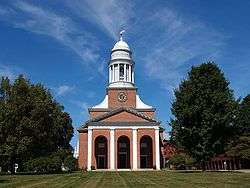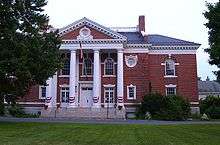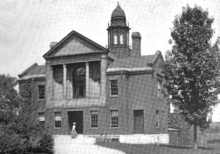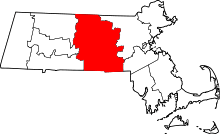Lancaster, Massachusetts
| Lancaster, Massachusetts | ||
|---|---|---|
| Town | ||
 | ||
| ||
| Nickname(s): Lancaster-on-the-Nashua | ||
 Location in Worcester County and the state of Massachusetts. | ||
| Coordinates: 42°27′20″N 71°40′25″W / 42.45556°N 71.67361°WCoordinates: 42°27′20″N 71°40′25″W / 42.45556°N 71.67361°W | ||
| Country | United States | |
| State | Massachusetts | |
| County | Worcester | |
| Settled | 1643 | |
| Incorporated | 1653 | |
| Government | ||
| • Type | Open town meeting | |
| • Town Administrator | Orlando Pacheco[1] | |
| • Board of Selectmen |
Stanley B. Starr, JR., Chairman Walter F. Sendrowski, Clerk Mark A. Grasso, JR., Member | |
| Area | ||
| • Total | 28.2 sq mi (73.0 km2) | |
| • Land | 27.7 sq mi (71.8 km2) | |
| • Water | 0.5 sq mi (1.3 km2) | |
| Elevation | 300 ft (91 m) | |
| Population (2010) | ||
| • Total | 8,055 | |
| • Density | 290/sq mi (110/km2) | |
| Time zone | UTC-5 (Eastern) | |
| • Summer (DST) | UTC-4 (Eastern) | |
| ZIP code | 01523 | |
| Area code(s) | 351 / 978 | |
| FIPS code | 25-34165 | |
| GNIS feature ID | 0618368 | |
| Website | www.ci.lancaster.ma.us | |
Lancaster is a town in Worcester County, Massachusetts, in the United States. Incorporated in 1653, Lancaster is the oldest town in Worcester County. As of the 2010 census, the town population was 8,055.
History

Lancaster was first settled as "Nashaway" (after the local Nashaway Native American tribe) in 1643. It was officially incorporated and renamed "Lancaster on the Nashua" in 1653. Until it was cut down in 1989 due to safety concerns, Lancaster boasted the largest oak tree in the state, called the Beaman Oak, named after settler Gamaliel Beaman (1623–1677).
Lancaster boasts being the official "mothertown" to all of Eastern central Massachusetts. Towns such as Harvard, Bolton, Leominster, Clinton, Berlin, Sterling, and part of West Boylston were all formed from territory of the original boundaries of Lancaster.[2]
Supporters of Lancaster's founder, John Prescott, born in 1604 (great grandfather of Bunker Hill leader William Prescott, wished to name the new settlement Prescott, but the Massachusetts General Court considered such a request from a common freeman presumptuous, given that at that time, not even a governor had held the honor of naming a town after himself. Instead, they decided to use Lancaster, the name of his home town in England.[3]
Lancaster was the site of the Mary Rowlandson (c. 1637–1711) attack in February 1676 (1675 old style calendar). During Metacom's War, which was fought partially in Lancaster, a group of Native Americans pillaged the entire town of Lancaster in response to English colonial brutality against them. Their last stop was Mary Rowlandson's house. Coming to the defense of the house was Rowlandson's brother-in-law, who was immediately shot and killed by the attacking Native Americans. The Native Americans then set fire to the house, forcing Rowlandson to exit the burning building. Upon crossing the doorstep, Rowlandson saw a scene full of carnage. The majority of her household was slaughtered, with the exception of her husband, Joseph Rowlandson Sr., who was not on the premises, their son, also called Joseph, their two daughters, Mary and Sarah, and herself. Mary, her son, and her two daughters were captured by the Native Americans and forced to join their travels across New England. The Native Americans non-fatally shot Mary Rowlandson in her side, but her youngest daughter, Sarah, sustained an injury during the attack that would later bring about her death. After her release from captivity, Rowlandson wrote a book called A Narrative of the Captivity and Restoration of Mrs. Mary Rowlandson. The book is widely considered one of the greatest examples of a captivity narrative. In 2000, Lancaster Elementary School changed its name to Mary Rowlandson Elementary School.
Geography
According to the United States Census Bureau, the town has a total area of 28.2 square miles (73 km2), of which 27.7 square miles (72 km2) is land and 0.5 square miles (1.3 km2), or 1.84%, is water.
Lancaster is bordered by Lunenburg and Shirley to the north, Harvard to the northeast, Bolton to the southeast, Clinton to the south, Sterling to the southwest, and Leominster to the northwest.
Demographics
| Historical population | ||
|---|---|---|
| Year | Pop. | ±% |
| 1850 | 1,688 | — |
| 1860 | 1,932 | +14.5% |
| 1870 | 1,845 | −4.5% |
| 1880 | 2,008 | +8.8% |
| 1890 | 2,201 | +9.6% |
| 1900 | 2,478 | +12.6% |
| 1910 | 2,564 | +3.5% |
| 1920 | 2,461 | −4.0% |
| 1930 | 2,897 | +17.7% |
| 1940 | 2,963 | +2.3% |
| 1950 | 3,601 | +21.5% |
| 1960 | 3,958 | +9.9% |
| 1970 | 6,095 | +54.0% |
| 1980 | 6,334 | +3.9% |
| 1990 | 6,661 | +5.2% |
| 2000 | 7,380 | +10.8% |
| 2010 | 8,055 | +9.1% |
| * = population estimate. Source: United States Census records and Population Estimates Program data.[4][5][6][7][8][9][10][11][12][13] | ||
As of the census[14] of 2010, there were 8,055 people, 2,409 households, and 1,758 families residing in the town. The population density was 290.8 people per square mile (112.3/km²). There were 2,614 housing units at an average density of 94.4 per square mile (36.5/km²). The racial makeup of the town was 86.4% White, 7.7% African American, 0.1% Native American, 1.7% Asian, 2.5% from other races, and 1.6% from two or more races. Hispanic or Latino of any race were 8.1% of the population.
There were 2,409 households out of which 31.6% had children under the age of 18 living with them, 60.2% were married couples living together, 3.8% had a male householder with no wife present, 9.0% had a female householder with no husband present, and 27.0% were non-families. Of all households 21.8% had a householder that lived alone and 8.4% had a householder that lived alone who was 65 years of age or older. The average household size was 2.66 and the average family size was 3.13.
In the town, the population was spread out with 23.6% at the age of 19 or under, 7.9% from 20 to 24, 27.5% from 25 to 44, 29.1% from 45 to 64, and 11.8% who were 65 years of age or older. The median age was 38.9 years. For every 100 females, there were 128.9 males. For every 100 females age 18 and over, there were 131.0 males.
As of the 2015 American Community Survey,[14] the median income for a household in the town was $96,813, and the median income for a family was $99,207. Males had a median income of $62,500 versus $45,174 for females. The per capita income for the town was $32,899. About 8.3% of families and 9.2% of the population were below the poverty line, including 17.1% of those under age 18 and 1.7% of those age 65 or over.
Government
| County-level state agency heads | |
|---|---|
| Clerk of Courts: | Dennis P. McManus (D) |
| District Attorney: | Joseph D. Early, Jr. (D) |
| Register of Deeds: | Anthony J. Vigliotti (D) |
| Register of Probate: | Stephanie K. Fattman (R) |
| County Sheriff: | Lew Evangelidis (R) |
| State government | |
| State Representative(s): | Harold P. Naughton, Jr. (D) |
| State Senator(s): | Vacant |
| Governor's Councilor(s): | Jen Caissie (R) |
| Federal government | |
| U.S. Representative(s): | Niki Tsongas (D) (3rd District), |
| U.S. Senators: | Elizabeth Warren (D), Ed Markey (D) |
Education
Lancaster is served by the Nashoba Regional School District. It is also the site of the former Atlantic Union College and of South Lancaster Academy, incorporated in 1882–1883. The Dr. Franklin Perkins School is a private special education school located in the town. Trivium School, founded in 1979, is a private Catholic college preparatory school occupying the former estate of E. V. R. Thayer, Jr.[15]
Library

Lancaster's public Thayer Memorial Library first opened in 1868.[16][17] In fiscal year 2008, the town of Lancaster spent 1.74% ($259,465) of its budget on its public library—some $36 per person.[18]
Notable people
- Herman Vandenburg Ames, dean of the University of Pennsylvania graduate school
- Luther Burbank, botanist, horticulturist and a pioneer in agricultural science
- Ezra Butler, United States Representative from Vermont
- James C. Carter, New York City lawyer
- Charles F. Chandler, chemist
- Horace Cleveland, landscape architect
- Francis B. Fay, merchant and politician
- Hannah Flagg Gould, poet
- Timothy Harrington, Lancaster clergyman[19]
- Abraham Haskell, physician[20]
- Stephen N. Haskell, clergyman and pioneering leader of the Seventh-day Adventist denomination, founded South Lancaster Academy
- Caroline Lee Hentz, novelist
- Henrietta Swan Leavitt, astronomer who discovered the relation between the luminosity and the period of Cepheid variable stars
- Charles W. Moors, Wisconsin politician
- Herbert Parker (Massachusetts politician), Republican politician, Massachusetts Attorney General from 1902-1906
- John Prescott, pioneer, founder of Lancaster
- Mary Rowlandson, colonial Indian captive and author of one of America's first best selling books
- Jared Sparks, historian, Harvard University president (taught at a private school in Lancaster 1815-1817)
- John Thayer, ornithologist
- Nathaniel Thayer, Unitarian congregational minister
- Nathaniel Thayer, financier and philanthropist
- John Whitcomb, soldier in the Continental Army[21]
- Henry Whiting, soldier in the War of 1812 and the Mexican–American War[22]
- Abijah Willard, Loyalist soldier in the American Revolution[23]
- Dr. Samuel Willard, representative to the Massachusetts ratification of the United States Constitution
- Michael Lovoi, YouTube animator also known as Slaminations
References
- ↑ Terry Date. "New town manager sworn in". The Andover Townsman.
- ↑ "The Lancastrian Towns", p. 33, Katherine Knowles, copyright 1967, The Lancaster Historical Commission.
- ↑ "The Lancastrian Towns", p. 11-14, Katherine Knowles, copyright 1967, The Lancaster Historical Commission.
- ↑ "Total Population (P1), 2010 Census Summary File 1". American FactFinder, All County Subdivisions within Massachusetts. United States Census Bureau. 2010.
- ↑ "Massachusetts by Place and County Subdivision - GCT-T1. Population Estimates". United States Census Bureau. Retrieved July 12, 2011.
- ↑ "1990 Census of Population, General Population Characteristics: Massachusetts" (PDF). US Census Bureau. December 1990. Table 76: General Characteristics of Persons, Households, and Families: 1990. 1990 CP-1-23. Retrieved July 12, 2011.
- ↑ "1980 Census of the Population, Number of Inhabitants: Massachusetts" (PDF). US Census Bureau. December 1981. Table 4. Populations of County Subdivisions: 1960 to 1980. PC80-1-A23. Retrieved July 12, 2011.
- ↑ "1950 Census of Population" (PDF). Bureau of the Census. 1952. Section 6, Pages 21-10 and 21-11, Massachusetts Table 6. Population of Counties by Minor Civil Divisions: 1930 to 1950. Retrieved July 12, 2011.
- ↑ "1920 Census of Population" (PDF). Bureau of the Census. Number of Inhabitants, by Counties and Minor Civil Divisions. Pages 21-5 through 21-7. Massachusetts Table 2. Population of Counties by Minor Civil Divisions: 1920, 1910, and 1920. Retrieved July 12, 2011.
- ↑ "1890 Census of the Population" (PDF). Department of the Interior, Census Office. Pages 179 through 182. Massachusetts Table 5. Population of States and Territories by Minor Civil Divisions: 1880 and 1890. Retrieved July 12, 2011.
- ↑ "1870 Census of the Population" (PDF). Department of the Interior, Census Office. 1872. Pages 217 through 220. Table IX. Population of Minor Civil Divisions, &c. Massachusetts. Retrieved July 12, 2011.
- ↑ "1860 Census" (PDF). Department of the Interior, Census Office. 1864. Pages 220 through 226. State of Massachusetts Table No. 3. Populations of Cities, Towns, &c. Retrieved July 12, 2011.
- ↑ "1850 Census" (PDF). Department of the Interior, Census Office. 1854. Pages 338 through 393. Populations of Cities, Towns, &c. Retrieved July 12, 2011.
- 1 2 "American FactFinder". United States Census Bureau. Retrieved 2017-06-17.
- ↑ Trivium School website
- ↑ C.B. Tillinghast. The free public libraries of Massachusetts. 1st Report of the Free Public Library Commission of Massachusetts. Boston: Wright & Potter, 1891. Google books
- ↑ http://thayermemoriallibrary.org/about/history Retrieved 2010-11-08
- ↑ July 1, 2007 through June 30, 2008; cf. The FY2008 Municipal Pie: What's Your Share? Commonwealth of Massachusetts, Board of Library Commissioners. Boston: 2009. Available: Municipal Pie Reports Archived 2012-01-23 at the Wayback Machine.. Retrieved 2010-08-04
- ↑

- ↑

- ↑

- ↑

- ↑

External links
| Wikimedia Commons has media related to Lancaster, Massachusetts. |
| Wikisource has the text of a 1920 Encyclopedia Americana article about Lancaster, Massachusetts. |
- Town of Lancaster official website
- Lancaster Online, community website
- Annals of Lancaster: The Massacre of February 10, 1676
- Information about early education in Lancaster
- Lancaster 2007 Master Plan maps and tables


